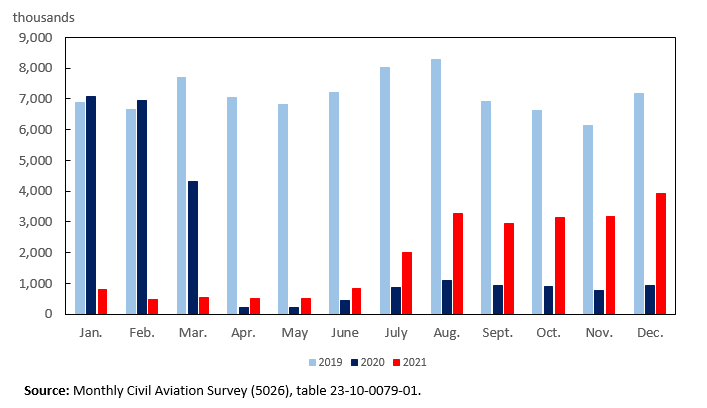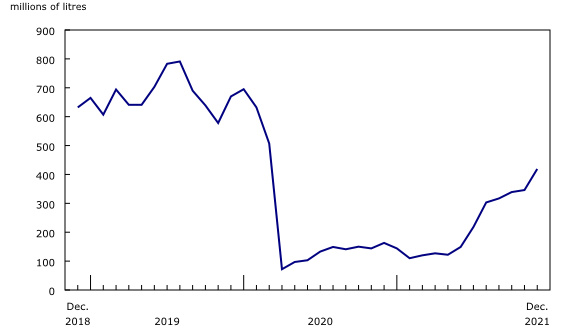Monthly civil aviation statistics, December 2021
Archived Content
Information identified as archived is provided for reference, research or recordkeeping purposes. It is not subject to the Government of Canada Web Standards and has not been altered or updated since it was archived. Please "contact us" to request a format other than those available.
Released: 2022-02-24
Highlights
Major Canadian airlines carried 3.9 million passengers on scheduled and charter services in December, making it the busiest month of 2021 for air travel. While this was well above the number of passengers carried in December 2020, it was a little over half (54.8%) of the pre-pandemic level reported in the same month in 2019.
Over the entire year, these large airlines carried a total of 22.1 million passengers in 2021. Despite sharp improvements during the second half of the year, the annual total number of passengers was just over one-quarter (25.9%) of those carried in 2019, before the pandemic.
Higher air traffic before restrictions tighten
As of November 30, eight more airports were permitted to accept international flights. This announcement was made in early November, before the discovery of the Omicron variant of COVID-19. In mid-December, the Government of Canada reintroduced an advisory against non-essential international travel. The impact of this new variant on air travel in December was not obvious, but reports of flight cancellations and schedule reductions in the first quarter of 2022 point towards a larger impact early in the new year.
On March 11, 2020, COVID-19 was declared a pandemic by the World Health Organization. In the months that followed, Canadian air travel remained well below historical levels. Unless otherwise specified, comparisons for a given month are made with the same month in 2019 (also referred to as "pre-pandemic levels"), when airline activity levels were in line with historical trends.
Another month of moderate improvements wraps up the year
Canadian Level I air carriers flew 3.9 million passengers on scheduled and charter services in December. This was down 45.2% from the pre-pandemic level of December 2019, a slight improvement over the 48.5% decrease reported in November (from November 2019). December was the busiest month of the year in terms of air travel in 2021, whereas typically August is the busiest.
As is the case in most years, the number of passengers on both domestic and international routes rose from November to December. In the international sector, this was the ninth consecutive month of increases.
At 9.3 billion passenger-kilometres, traffic in December was 49.4% below the pre-pandemic level posted in December 2019. Capacity was 13.6 billion available seat-kilometres, down 38.2% from December 2019.
The passenger load factor (the ratio of passenger-kilometres to available seat-kilometres) was 68.4% in December 2021, compared with 83.6% in December 2019.
Each passenger travelled an average of 2,369 kilometres in December, the highest average distance since March 2020. This was down 7.7% from December 2019.
At 125,000, the number of flying hours in December was 34.9% below the pre-pandemic level and surpassed 100,000 for the first time since March 2020.
Operating revenue earned by Level I carriers totalled $1.4 billion in December, the highest since the pandemic began. However, this marked a decline of 35.4% from the $2.2 billion reported in December 2019.
The year in review
Throughout 2021, the COVID-19 pandemic continued to affect aviation in Canada and around the world. Several Canadian air carriers suspended their operations for periods of time during 2021, but by the fourth quarter all Level I carriers had resumed their operations.
The year began with lockdowns across Canada amid rising COVID-19 cases, and a new variant first found in the United Kingdom prompted a ban on flights from that country. Additional travel restrictions were introduced, with a pre-departure PCR test required from January 7 and hotel quarantine as of February 22. At the end of January, flights to Mexico and the Caribbean were suspended until April 30, with most airlines later extending the suspension. As a result, the number of passengers transported by Canadian Level I air carriers declined in early 2021 compared with the last few months of 2020.
The emergence of the Delta variant prompted a ban on flights from India, which lasted for five months, and those from Pakistan for two months. Flights from Morocco were also prohibited for a period of time in the autumn.
Increasing vaccination rates in the summer prompted provinces to begin relaxing restrictions on gatherings, as well as on interprovincial travel. Between July and September, international travel restrictions were gradually relaxed for travellers fully vaccinated with a vaccine approved by Health Canada. Passenger volumes increased and remained above 2 million every month since July.
After staying below 50% for 15 consecutive months, the passenger load factor increased to stabilize between 67% and 70% from July until the end of the year. It reached 78% in August, generally the busiest month for air travel.
Towards the end of the year, the emergence of the Omicron variant prompted a new advisory against non-essential international travel and a tightening of travel restrictions. It remains to be seen what effect this will have on aviation in early 2022.
To summarize 2021, Level I air carriers transported 22.1 million passengers, just over one-quarter (25.9%) of the number carried in 2019, before the pandemic. Traffic was at 49.0 billion passenger-kilometres, and capacity at 76.7 billion available seat-kilometres. The number of flying hours declined to 695,000. Operating revenue totalled $7.3 billion, 28.7% of the 2019 level.
Note to readers
The Monthly Civil Aviation Survey covers all Canadian Level I air carriers: Air Canada (including Air Canada Rouge), Air Transat, Jazz, Porter, Sunwing and WestJet (including Swoop, WestJet Encore and WestJet Link).
The average passenger trip length is calculated by dividing the number of passenger-kilometres by the number of passengers. Trips across Canada and around the world are included in this calculation.
The data in this monthly release are not seasonally adjusted.
Contact information
For more information, or to enquire about the concepts, methods or data quality of this release, contact us (toll-free 1-800-263-1136; 514-283-8300; infostats@statcan.gc.ca) or Media Relations (statcan.mediahotline-ligneinfomedias.statcan@statcan.gc.ca).
- Date modified:






